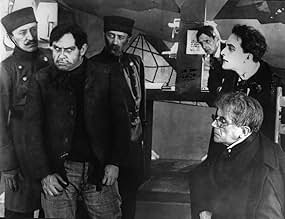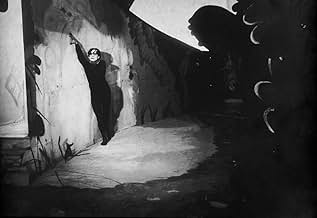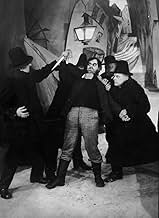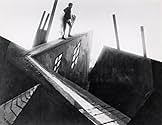CALIFICACIÓN DE IMDb
8.0/10
74 k
TU CALIFICACIÓN
El doctor Caligari, un hipnotista, usa a Cesare, sonámbulo, para cometer asesinatos.El doctor Caligari, un hipnotista, usa a Cesare, sonámbulo, para cometer asesinatos.El doctor Caligari, un hipnotista, usa a Cesare, sonámbulo, para cometer asesinatos.
- Dirección
- Guionistas
- Elenco
- Premios
- 2 premios ganados y 1 nominación en total
Friedrich Feher
- Franzis
- (as Friedrich Fehér)
Hans Heinrich von Twardowski
- Alan
- (as Hans Heinz v. Twardowski)
Rudolf Lettinger
- Dr. Olsen
- (as Rudolph Lettinger)
Rudolf Klein-Rogge
- Ein Verbrecher
- (sin créditos)
- …
Hans Lanser-Ludolff
- Ein Alter Mann
- (sin créditos)
- …
Henri Peters-Arnolds
- Ein Junger Arzt
- (sin créditos)
- …
Ludwig Rex
- Ein Mörder
- (sin créditos)
- …
Elsa Wagner
- Die Wirtin
- (sin créditos)
- …
- Dirección
- Guionistas
- Todo el elenco y el equipo
- Producción, taquilla y más en IMDbPro
Opiniones destacadas
It struck me last night that I've never seen a serious silent film. Everyone's seen a silent comedy: Charlie Chaplin, Buster Keaton, the Keystone Cops... They've all been immortalized in the minds of every film viewer, and I enjoy them as much as anyone. But it seems a strange and almost disrespectful lack to never have seen anything but comedy; so many silent films were created, and the only ones I've seen starred waddling tramps.
It was partially for that reason that I rented this movie. I had read about it on a film review site (the name of which escapes my memory) and decided it was worth the half-hour drive to the video store. The basic premise is that of a man relating a story that happened to him and his friends - their unnerving discovery of a crazed mountebank, Dr. Caligari, and his prophetic sleepwalker. It follows a series of murders and growing madness, keeping you in constant suspense and confusion until the very last scene.
There's a period of adjustment when watching it - unfortunately necessary for a modern audience. The titles seem too slow. The camera seems to hold on scenes too long. The makeup on the actors' faces seem ghostly and horrible - even on the hero.
But before long, the movie has you in its grip. You spend time staring at the architecture - buildings, doors, and windows that would have been funny in a Dr. Seuss book. In the film, they make you uneasy. The whole atmosphere is of a world gone wrong; like a dream worthy of Salvador Dalí. Nothing is square or straight. The buildings loom in on you; windows sweep upward, slanted or curved; doors are obscenely angled holes beckoning you to enter and be trapped inside.
Throughout, the story defies expectations. Small plot twists confuse and mislead you until the final surprise, completely tearing down everything you thought the movie was about. Strange shadows and shots from inside alleys paint the film's world as something terrible, never allowing you a normal look at the village, never allowing you to enjoy the quaintness of it. Through it all, the grinning, hunched figure of Dr. Caligari hangs in your mind, pushing out rational thought.
The movie is well worth your time; there's a certain pleasure in trying to capture the feeling of terror an early audience, unaccustomed to the visual effects we see every day, would have had the first time they saw this movie. It's an intellectual terror in the grand old style, giving you the same thrill you get from reading Frankenstein or Dr. Jekyll and Mr. Hyde. At the risk of sounding cliché: two thumbs up!
It was partially for that reason that I rented this movie. I had read about it on a film review site (the name of which escapes my memory) and decided it was worth the half-hour drive to the video store. The basic premise is that of a man relating a story that happened to him and his friends - their unnerving discovery of a crazed mountebank, Dr. Caligari, and his prophetic sleepwalker. It follows a series of murders and growing madness, keeping you in constant suspense and confusion until the very last scene.
There's a period of adjustment when watching it - unfortunately necessary for a modern audience. The titles seem too slow. The camera seems to hold on scenes too long. The makeup on the actors' faces seem ghostly and horrible - even on the hero.
But before long, the movie has you in its grip. You spend time staring at the architecture - buildings, doors, and windows that would have been funny in a Dr. Seuss book. In the film, they make you uneasy. The whole atmosphere is of a world gone wrong; like a dream worthy of Salvador Dalí. Nothing is square or straight. The buildings loom in on you; windows sweep upward, slanted or curved; doors are obscenely angled holes beckoning you to enter and be trapped inside.
Throughout, the story defies expectations. Small plot twists confuse and mislead you until the final surprise, completely tearing down everything you thought the movie was about. Strange shadows and shots from inside alleys paint the film's world as something terrible, never allowing you a normal look at the village, never allowing you to enjoy the quaintness of it. Through it all, the grinning, hunched figure of Dr. Caligari hangs in your mind, pushing out rational thought.
The movie is well worth your time; there's a certain pleasure in trying to capture the feeling of terror an early audience, unaccustomed to the visual effects we see every day, would have had the first time they saw this movie. It's an intellectual terror in the grand old style, giving you the same thrill you get from reading Frankenstein or Dr. Jekyll and Mr. Hyde. At the risk of sounding cliché: two thumbs up!
With a story as twisted, buckled and demented as the scenery and set design, and a tortured score to boot, was the lunatic in charge of the asylum? Must have been a moment to remember coming across this cinematic marvel back in 1920. I wonder how many of today's pieces of cinema will stand the test of 100 years, albeit with a lot more competition.
The original message of this film is fairly pedestrian (an outcry against the weak authority in Germany at the time), although the political intrigue surrounding the production led to a fascinating framing story which re-established "the authorities," and in turn made the UFA happy enough to distribute the film. This suggests that in its own time the political message of the film was fairly powerful, but compared to the work done in such films as The Golem, Nosferatu, and Metropolis it is not so far-reaching.
What sets this film apart from its contemporaries is its absolute commitment to the expressionist movement. Mutated sets, heavy dark/light makeup, light and shadow, and a Gothic storyline are classic expressionism. The photography is beautiful and so crisp that it creates an eerie sense that this hellish scene is actually the real world, and that our everyday lives are the delusional Technicolor dream of a madman.
While there are many better movies made in this period, I feel that this one is the pinnacle of the imagery that is characteristic of the expressionist art form. It is an absolute must-see for anyone who is interested in the Expressionist movement.
What sets this film apart from its contemporaries is its absolute commitment to the expressionist movement. Mutated sets, heavy dark/light makeup, light and shadow, and a Gothic storyline are classic expressionism. The photography is beautiful and so crisp that it creates an eerie sense that this hellish scene is actually the real world, and that our everyday lives are the delusional Technicolor dream of a madman.
While there are many better movies made in this period, I feel that this one is the pinnacle of the imagery that is characteristic of the expressionist art form. It is an absolute must-see for anyone who is interested in the Expressionist movement.
Having only started discovering silent movies recently, I don't have more than a handful of other non-talkies to compare it to. This however was not only one of the best, most compelling and unique silents I have seen, but also a great flick overall. It's all been said before, I'm sure, but I'll say it again: this is a milestone of German Expressionist cinema. It is also a class-A mind-phuck movie (excuse my French), one of those stories that'll leave you eternally scratching your head trying to figure out what you've seen, what to believe and what can be a plausible explanation for most of the creepy mysteries you've just witnessed. Right from the very opening scene, seemingly suspended in an otherworldly dimension, maybe somewhere in between life and death, in which the first line spoken is: "There are spirits everywhere", you realise you are in for a spooky ride (this is the ultimate Halloween movie, come to think of it!) Having studied theatre set and costume design at Rome's art school for a year before going to university, I was obviously completely fascinated by the set design choices here. Buildings and furniture, props and painted backdrops are elongated and deformed into blocky, savage, expressionistic, perspective-defying and proportion-less forms. Even the intertitles weren't of the traditional sort. The result is obviously one of unsettling the viewer further into believing themselves suspended in a reality where anything could happen - anything horrible or nightmarish, obviously. Nothing is as it seems, right to the very end. Btw, on a more frivolous note, I thought the character of Cesare the Somnambulist looked uncannily like something that might have influenced Tim Burton into creating Edward Scissorhands, or maybe even more, the look of some of the characters in Rocky Horror Picture Show.
I vowed to see more horror films this year, and this was recommended to me, initially I was a little dubious with it being a hundred plus years old, and a silent film, but I have to say I have a real appreciation for it.
Without a doubt, this film must be the inspiration for the whole horror genre, a genre that scares and shocks people to this day, you can only I shine the profound effect that this film must have had on viewers back in its time.
Hugely atmospheric and creepy, if I'm honest, it is slow, and you do need to concentrate, or you'll lose it, no texting or phone play, it is a fairly intense watch, best of all is the ending, which really does come as a surprise, it's something of a twist.
It is definitely not for everyone, and if you're used to modern horror, you may find ten minutes of it an arduous task, but having watched Nose earlier in the year, I have a real appreciation for this early gem.
An admirable film, 8/10.
Without a doubt, this film must be the inspiration for the whole horror genre, a genre that scares and shocks people to this day, you can only I shine the profound effect that this film must have had on viewers back in its time.
Hugely atmospheric and creepy, if I'm honest, it is slow, and you do need to concentrate, or you'll lose it, no texting or phone play, it is a fairly intense watch, best of all is the ending, which really does come as a surprise, it's something of a twist.
It is definitely not for everyone, and if you're used to modern horror, you may find ten minutes of it an arduous task, but having watched Nose earlier in the year, I have a real appreciation for this early gem.
An admirable film, 8/10.
¿Sabías que…?
- TriviaWriter Hans Janowitz claims to have gotten the idea for the film when he was at a carnival one day. He saw a strange man lurking in the shadows. The next day he heard that a girl was brutally murdered there. He went to the funeral and saw the same man lurking around. He had no proof that the strange man was the murderer, but he fleshed the whole idea out into his film.
- ErroresIn the wide shot, the sign at the asylum reads "Insane Asylum," in English. In the close-up, the sign is written in German (Kino Blu-ray Disc version, may not be present in all editions of the film).
- Versiones alternativasUSA laserdisc reissue restores the original hand-drawn title cards that have been missing from every known print of the film since 1923. When first released on video in the United States, film was in black-and-white, and played back many scenes at double speed and featured different music. Although no scenes were cut out, the running time was reduced to only 51 minutes. The restored version restores the colour-tinting, restores the original title cards, and plays the film back at regular speed, returning the film to its original 69-minute running time.
- ConexionesEdited into People Who Die Mysteriously in Their Sleep (2004)
Selecciones populares
Inicia sesión para calificar y agrega a la lista de videos para obtener recomendaciones personalizadas
Detalles
- Fecha de lanzamiento
- País de origen
- Idioma
- También se conoce como
- The Cabinet of Dr. Caligari
- Locaciones de filmación
- Productora
- Ver más créditos de la compañía en IMDbPro
Taquilla
- Presupuesto
- USD 18,000 (estimado)
- Total en EE. UU. y Canadá
- USD 8,811
- Total a nivel mundial
- USD 9,297
- Tiempo de ejecución
- 1h 16min(76 min)
- Mezcla de sonido
- Relación de aspecto
- 1.37 : 1
Contribuir a esta página
Sugiere una edición o agrega el contenido que falta





























